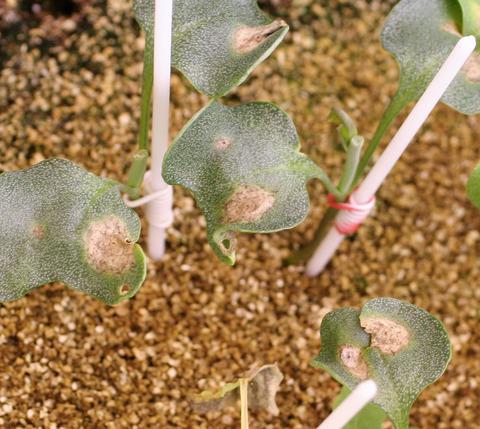当前位置:
X-MOL 学术
›
Mol. Plant Pathol.
›
论文详情
Our official English website, www.x-mol.net, welcomes your
feedback! (Note: you will need to create a separate account there.)
A new avirulence gene of Leptosphaeria maculans, AvrLm14, identifies a resistance source in American broccoli (Brassica oleracea) genotypes
Molecular Plant Pathology ( IF 4.8 ) Pub Date : 2021-08-31 , DOI: 10.1111/mpp.13131 Alexandre Degrave 1 , Marine Wagner 1 , Pierre George 2 , Laurent Coudard 1 , Xavier Pinochet 3 , Magali Ermel 4 , Elise J Gay 1 , Isabelle Fudal 1 , Onesimo Moreno-Rico 5 , Thierry Rouxel 1 , Marie-Hélène Balesdent 1
Molecular Plant Pathology ( IF 4.8 ) Pub Date : 2021-08-31 , DOI: 10.1111/mpp.13131 Alexandre Degrave 1 , Marine Wagner 1 , Pierre George 2 , Laurent Coudard 1 , Xavier Pinochet 3 , Magali Ermel 4 , Elise J Gay 1 , Isabelle Fudal 1 , Onesimo Moreno-Rico 5 , Thierry Rouxel 1 , Marie-Hélène Balesdent 1
Affiliation

|
In many cultivated crops, sources of resistance to diseases are sparse and rely on introgression from wild relatives. Agricultural crops often are allopolyploids resulting from interspecific crosses between related species, which are sources of diversity for resistance genes. This is the case for Brassica napus (oilseed rape, canola), an interspecific hybrid between Brassica rapa (turnip) and Brassica oleracea (cabbage). B. napus has a narrow genetic basis and few effective resistance genes against stem canker (blackleg) disease, caused by the fungus Leptosphaeria maculans, are currently available. B. rapa diversity has proven to be a valuable source of resistance (Rlm, LepR) genes, while B. oleracea genotypes were mostly considered susceptible. Here we identified a new resistance source in B. oleracea genotypes from America, potentially effective against French L. maculans isolates under both controlled and field conditions. Genetic analysis of fungal avirulence and subsequent cloning and validation identified a new avirulence gene termed AvrLm14 and suggested a typical gene-for-gene interaction between AvrLm14 and the postulated Rlm14 gene. AvrLm14 shares all the usual characteristics of L. maculans avirulence genes: it is hosted in a genomic region enriched in transposable elements and heterochromatin marks H3K9me3, its expression is repressed during vegetative growth but shows a strong overexpression 5–9 days following cotyledon infection, and it encodes a small secreted protein enriched in cysteine residues with few matches in databases. Similar to the previously cloned AvrLm10-A, AvrLm14 contributes to reduce lesion size on susceptible cotyledons, pointing to a complex interplay between effectors promoting or reducing lesion development.
中文翻译:

斑点球菌 (Leptosphaeria maculans) 的一个新无毒基因 AvrLm14 确定了美国西兰花 (Brassica oleracea) 基因型中的抗性来源
在许多栽培作物中,抗病来源很少,并且依赖于野生近缘种的基因渗入。农作物通常是由相关物种之间的种间杂交产生的异源多倍体,这是抗性基因多样性的来源。甘蓝型油菜( Brassica napus) (油菜、油菜)就是这种情况,它是甘蓝(Brassica rapa )和甘蓝( Brassica oleracea )之间的种间杂种。欧洲油菜的遗传基础很窄,目前针对由真菌Leptosphaeria maculans引起的茎溃疡病(黑腿病)的有效抗性基因很少。白菜多样性已被证明是抗性( Rlm 、 LepR )基因的宝贵来源,而甘蓝基因型大多被认为是易受影响的。在这里,我们在来自美国的甘蓝基因型中发现了一种新的抗性来源,在对照和田间条件下,该来源可能对法国斑马菌菌株有效。真菌无毒力的遗传分析以及随后的克隆和验证鉴定出一种新的无毒力基因,称为AvrLm14 ,并表明AvrLm14和假定的Rlm14基因之间存在典型的基因间相互作用。 AvrLm14具有L的所有常见特征。maculans 无毒基因:它位于富含转座元件和异染色质标记 H3K9me3 的基因组区域,其表达在营养生长过程中受到抑制,但在子叶感染后 5-9 天表现出强烈的过度表达,并且它编码富含半胱氨酸的小型分泌蛋白数据库中几乎没有匹配的残基。与之前克隆的AvrLm10-A类似, AvrLm14有助于减少易感子叶上的病变大小,表明促进或减少病变发展的效应子之间存在复杂的相互作用。
更新日期:2021-08-31
中文翻译:

斑点球菌 (Leptosphaeria maculans) 的一个新无毒基因 AvrLm14 确定了美国西兰花 (Brassica oleracea) 基因型中的抗性来源
在许多栽培作物中,抗病来源很少,并且依赖于野生近缘种的基因渗入。农作物通常是由相关物种之间的种间杂交产生的异源多倍体,这是抗性基因多样性的来源。甘蓝型油菜( Brassica napus) (油菜、油菜)就是这种情况,它是甘蓝(Brassica rapa )和甘蓝( Brassica oleracea )之间的种间杂种。欧洲油菜的遗传基础很窄,目前针对由真菌Leptosphaeria maculans引起的茎溃疡病(黑腿病)的有效抗性基因很少。白菜多样性已被证明是抗性( Rlm 、 LepR )基因的宝贵来源,而甘蓝基因型大多被认为是易受影响的。在这里,我们在来自美国的甘蓝基因型中发现了一种新的抗性来源,在对照和田间条件下,该来源可能对法国斑马菌菌株有效。真菌无毒力的遗传分析以及随后的克隆和验证鉴定出一种新的无毒力基因,称为AvrLm14 ,并表明AvrLm14和假定的Rlm14基因之间存在典型的基因间相互作用。 AvrLm14具有L的所有常见特征。maculans 无毒基因:它位于富含转座元件和异染色质标记 H3K9me3 的基因组区域,其表达在营养生长过程中受到抑制,但在子叶感染后 5-9 天表现出强烈的过度表达,并且它编码富含半胱氨酸的小型分泌蛋白数据库中几乎没有匹配的残基。与之前克隆的AvrLm10-A类似, AvrLm14有助于减少易感子叶上的病变大小,表明促进或减少病变发展的效应子之间存在复杂的相互作用。











































 京公网安备 11010802027423号
京公网安备 11010802027423号